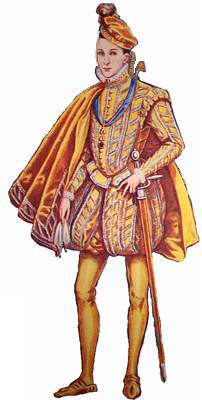Conventions and symbols
Colours were often symbolic: Tamburlaine's degrees of mercy are reflected in the changing colours of his robes*; Hamlet's mood is reflected in his black attire; and in Twelfth Night Malvolio's yellow hose indicate his new identity as a lover ("not black in my mind, though yellow in my legs.")
Conventions were also used to indicate different professions: doctors wore scarlet gowns, lawyers wore black, and serving men were dressed in blue coats. Long wigs were used for madwomen, while "moors" wore black velvet masks, long black gloves and leggings, all of which were later replaced by black paint. Henslowe's Diary again provides examples*.
Footnotes
-
Bloody colours
A Messenger warns of Tamburlaine's tactics:
The first day when he pitcheth down his tents,
White is their hue, and on his silver crest,
A snowy feather spangled white he bears,
To signify the mildness of his mind,
That, satiate with spoil, refuseth blood.
But when Aurora [dawn] mounts the second time
As red as scarlet is his furniture [equipment];
Then must his kindled wrath be quenched with blood,
Not sparing any that can manage arms;
But if these threats move not submission,
Black are his colours, black pavilion [tent];
His spear, his shield, his horse, his armour, plumes,
And jetty [jet-black] feathers, menace death and hell!
Without respect of sex, degree, or age,
He razeth all his foes with fire and sword.
(Tamburlaine, Part One, 4.1.49-63) -
From Henslowe's Diary
Item, i friar's gown.
Item, i little double for boy.
Item, i senator's gown, i hood, and 5 senator's capes.
Item, vi green coats for Robin Hood, and iiii knaves' suits.
Item, Eve's bodice. . . i ghost's suit and i ghost's bodice
Item, i Moor's coat
Item, i Pig's damask gown. . . i little jacket for Pig.
[John Pig was a child actor in Henslowe's company.]
